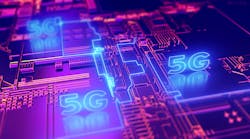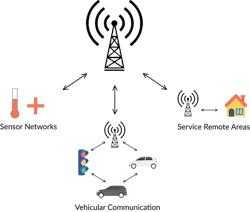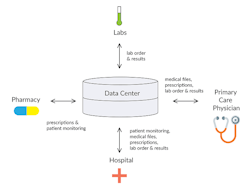This article appeared in Microwaves & RF and has been published here with permission.
>> Electronic Design Resources
.. >> Digital Editions
.. .. >> Top Stories of the Week
.. .. .. >> 2021 Electronic Design Forecasts
What you’ll learn:
- The improvements 5G will bring to cellular networks.
- Industries and applications that will benefit from 5G.
- How SDR brings improved interoperability to 5G networks.
5G is the newest communication standard coming from the 3GPP global initiative that’s taking the world by storm. Even though this technology is still under development and will take years to implement across the globe, it’s no wonder that it generates so much buzz. 5G shows huge promise to improve on 4G in every aspect, such as bandwidth, data rates, and latency.
For instance, 5G allows for an increase in bandwidth from 140 to 800 MHz, which also means a spike in data rates from 100 Mb/s to 1 Gb/s and more. 5G also has a significant edge in terms of latency, improving the 20-ms latency of 4G to 1 ms.
If these improvements weren’t enough, 5G increases the number of serviceable devices within a square kilometer from 100,000 to 1,000,000. This means that 5G will enable faster connections and support an increase of users with the same number of base stations. Thus, base stations must be updated to support the new protocol. Software-defined radios (SDRs) easily accomplish that task, because they can handle ultra-wide bandwidth connections over a large frequency spectrum. SDR also allows for an upgrade path with future-generation standards using the same hardware with software updates.
Interoperability
The biggest opportunity afforded by 5G is interoperability, or the ability of computer systems to exchange and utilize information. A 5G infrastructure can serve to link any group of devices together, not just cellular phones.
The wireless cellular network system can be thought of as a new type of utility, where the resource being distributed is information. The underlying physical network consists of user devices, base stations, and central operators linking the end points of each communication. Communication protocols, such as 5G, provide an optimized protocol to exchange information between nodes.
An important consideration in creating systems that support interoperability is the advancement of communications technology. Like its predecessors, 5G will one day become obsolete, so the network infrastructure should have the capacity to adapt to the market and be able to update and support new devices that will join its network.
The flexibility of SDR makes it perfect for such an application because it can be implemented in any system and supports many protocols simultaneously. SDRs can be implemented in base stations; when it comes time to update the communication protocol, SDRs only require a relatively simple software update. This flexibility also allows for the integrated network to not hinge on any single technology and remain operational far longer than the lifespan of the 5G protocol.
Applications of 5G
The largest uncertainty with the future of 5G is how this new technology will be monetized. By building a flexible framework that responds to the market, telecommunications companies can improve their revenue per user significantly.
While consumers will see some benefit, the biggest beneficiaries of these advances will be enterprises and remote users. If the value of this technology is properly showcased, many industries can be targeted as new sources of revenue. Some of the industries that will immediately benefit from a 5G network are the cloud-computing, automotive, agriculture, and healthcare industries (Fig. 1).
Consumers
Consumers, especially in urban areas, will see an improvement in broadband connection and increased speed from their mobile networks. Another huge consumer market that could be revolutionized by 5G is the Internet of Things (IoT) devices that have gained prominence over the past decades. Instead of including computers in every sensor and IoT device, the devices can forgo the computing power and get their instructions from a nearby edge-computing system. Kitchen appliances, climate control systems, and health monitors can be produced more easily and monitored more closely by the manufacturer.
Wide-area networks (WAN) may not be necessary given the 5G coverage area. This could possibly eliminate the need for Wi-Fi routers and revolutionize internet service provider plans for consumers.
Cloud and Edge Computing
5G networks could potentially distribute cloud-computing services much closer to users than most large data centers implemented today. Edge computing may become a reality, bringing processing power closer to the customers, and minimizing latencies caused by distance. If latencies can be reduced enough, many tasks that require a computer would be able to run on cloud=computing centers, and users could use smaller, less-powerful devices to run the same tasks.
Automotive Industry
The automotive industry is moving toward autonomous driving, and the crux of that problem is gathering enough information for the vehicle to make the right decision. With the proper 5G infrastructure, vehicles could not only communicate with one another to maintain proper spacing, but also provide information to the driver about road conditions, security, delays and so on.
In addition, the vehicles could deliver performance information to the manufacturers to aid in improving the product and ensure the safety of the drivers and pedestrians alike. The 1-ms latency of 5G is very important in this application: Out-of-date information could mean the difference between life and death.
Agriculture Industry
Remote users are traditionally underserved by current network infrastructure. 5G has the potential to not only bring better service to rural areas, but also to bring all of the benefits of faster data-transfer rates, enabling some interesting applications.
Farmers should be particularly interested in the new technology because it can allow for autonomous crop monitoring with IoT sensors. Moisture and nutrient sensors could be scattered throughout their crops and connected with the 5G infrastructure, giving the farmer a map of their crops, and highlighting areas that need maintenance. With more information at their disposal, farms can more efficiently use resources and increase profits.
Healthcare
Healthcare could see a massive improvement with the low-latency communication capabilities of 5G. Patients in rural areas would not need to travel to large cities to receive better treatment, as caregivers in rural areas could receive instructions from the best healthcare professionals anywhere in the world. Medical records could be shared more easily between healthcare facilities, providing professionals with crucial information about their patients (Fig. 2).
Telemedicine, remote surgery, and physical therapy through augmented reality (AR) could be implemented, which have become especially important throughout the COVID-19 pandemic to keep healthcare professionals safe. Hospitals would have the ability to build sensor networks to monitor their patients, and smart medication packaging could track patients’ compliance. This would not only help physicians, but insurance companies as well.
Conclusion
5G is a communications protocol that will increase data-transfer rates and decrease latency of wireless networks. This advance enables improvement and autonomy in many industries, such as the cloud-computing, automotive, agriculture, and healthcare industries, and will revolutionize the way we use and transfer data.


